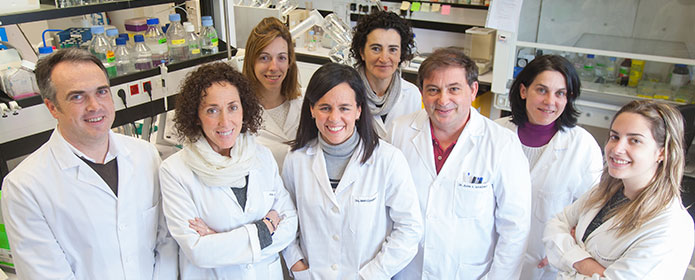CIMA researchers find a molecule which eliminates the symptoms and diminishes the progress of Alzheimer’s disease in mice
Therapeutic use in patients may restore the loss of memory caused by the disease

Researchers at the Centre for Applied Medical Research (CIMA) at the University of Navarra have discovered a new molecule which eliminates the symptoms of Alzheimer’s disease, and moreover diminishes its neurodegenerative process in mice. Thus the animals treated with CM-414 showed a reduction in the main markers of the disease (the amyloid beta peptide —the main component of the senile plaques associated with the disease which are formed in the brain— and the phosphorylated tau protein) together with an increase in the neuronal synapses. The results of this research have been published in the scientific journal Neuropsychopharmacology, part of the Nature group.
The new CM-414 molecule acts as a dual inhibitor of enzymes involved in the pathology of Alzheimer’s: histone deacetylase (HDAC) and phosphodiesterase type 5 PDE5), the increase of which in the brain, found in patient samples, is associated with the cognitive impairment that is characteristic of the disease. “After the simultaneous inhibition of these enzymes, whose individual effectivity had been proven previously, we have observed a strengthening of the therapeutic effect which reverses the symptomatology and slows down the progress of Alzheimer’s disease in mice”, said Dr. Ana García-Osta, the head of the CIMA laboratory working on Alzheimer’s disease and one of the authors of the article. This research has been carried out on mice models of Alzheimer's disease. After treating them with CM-414, scientists evaluated their learning ability and spatial memory with the Morris water maze experiment.
For this discovery the CIMA researchers first validated this new therapeutic approach by combining referenced compounds. Subsequently, over 200 molecules capable of inhibiting these two enzymes were designed and synthesized, with the CM-414 compound showing the greatest therapeutic potential. The results of this research were published in the Journal of Medicinal Chemistry, one of the most important scientific journals in the area.
The therapeutic potential of the new moleculeThe CM-414 molecule acts as a starting point to develop a new treatment strategy for Alzheimer’s disease. The next step, said Dr. Julen Oyarzabal, another author of the article and director of the CIMA Molecular Therapy Program, “will be the optimization of this compound in order to find a molecule with an optimum effectivity and safety profile, a clinical candidate which will allow for tests on patients with this neurodegenerative disease”.
The great therapeutic potential of this molecule is reflected in the latest issue of Biocentury Innovations, a leading publication which offers information on cutting-edge translational science that is commercially promising for biotechnological and pharmaceutical companies, academics and public and private investors. The CIMA works stood out among the review of over 400 articles published in 41 high-impact journals.
